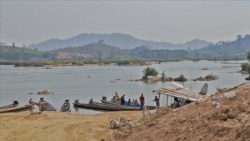Thai activists and organizations have raised alarm bells following last month’s announcement that the Mekong River Commission will begin its prior consultation process on the Sanakham hydropower plant, a new Mekong River dam project in northern Laos.
The plant would be the sixth dam in Laos, costing more than $2 billion, and would follow Laos’ Xayaburi Dam, farther upstream, which began operation in November.
The MRC prior consultation process normally lasts for six months, during which other MRC members, including Thailand, Cambodia and Vietnam, can review the project and assess any cross-border impacts.
While members can suggest changes, the MRC consultation process cannot veto projects, meaning the Sanakham project will move forward.
Save the Mekong, a coalition of organizations and academics, said June 2 the proposed dam is expensive, unnecessary and risky, and should be canceled.
“Now is the time to cancel the Mekong mainstream dams permanently and prioritise sustainable and equitable energy options and pathways that respect the rights of communities,” the group said.
Like the Xayaburi Dam, the electricity generated by the Sanakham project would mainly be exported to Thailand, a country many observers say is already oversupplied with power.
“Records show that electric plants in the region generate enough power already and the Sanakham dam will only add more problems for the people living and working along the river,” according to Ormbun Thipsuna, spokesperson for the Network of Thai People in Eight Mekong Provinces.
The organization was scheduled to meet Thai government officials in March to discuss the potential adverse effects of the newly operational Xayaburi dam, along with concerns about the proposed Sanakham project. The meeting was postponed because of the COVID-19 pandemic.
The Lower Mekong Basin had record-low water levels in the last half of last year, which exacerbated Thailand’s worst drought in 40 years at the beginning of 2020, affecting farmers who heavily depend on the waterway for irrigation.
Critics say that new dam will only make conditions worse.
“According to villagers in Loei [a northeastern Thai province on the Mekong], downstream of the proposed Sanakham dam site, the push for the Sanakham project will greatly aggravate the environmental and social problems within the Mekong river on the communities in the lower Mekong basin,” Paiporn Deetes, of the conservationist group International Rivers, said.
“Data notification,” Deetes added, referring to the limited environmental information supplied by countries where the dams operate, particularly in the Upper Mekong Basin, controlled by China, “which until now has been made through government channels, has failed to keep the public sufficiently informed and has also failed to address transboundary impacts.”
“Most importantly, the notifications have not addressed the impacts on downstream communities and the ecological system,” he said.
Many groups in the Save the Mekong coalition are calling for a moratorium on large-scale hydropower dams, similar to Cambodia’s March decision to impose a 10-year ban on new dam building along the section of the river there.
Although China is not a commission member, the country extends a strong influence in the region through investments and loans.
The MRC released a statement calling for greater transparency after the April release of a report saying Chinese Upper Mekong dams had held back water, creating low water levels in the Lower Mekong Basin.
The report, by water research and consulting company Eyes on Earth, combined daily satellite imagery from 1992 to 2019 with daily river height gauge data to assist in their conclusions that the 11 Chinese Upper Mekong Basin dams, have held back water to fill local reservoirs for long-term storage.
“The need for all the countries along the length of the Mekong to strike a balance between the benefits of development, social justice, and environmental sustainability is so paramount. A transparent data sharing arrangement on how water and related infrastructures are operated will help everyone manage risks and avoid misperception,” said An Pich Hatda, the MRC Secretariat’s chief executive officer.
The date for the beginning of the Sanakham consultation will be announced after the completion of the previous MRC consultation process, assessing the Luang Prabang dam project, another Laos - based dam, which will conclude June 30.
Datang Sanakham Energy, is the contractor of the Sanakham project, a subsidiary of China’s Datang International Power Generation Co. - a state-owned company.








